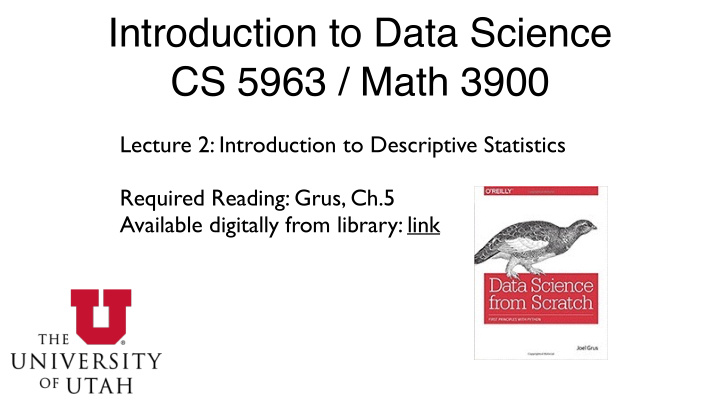



Introduction to Data Science CS 5963 / Math 3900 Lecture 2: Introduction to Descriptive Statistics Required Reading: Grus, Ch.5 Available digitally from library: link
Statistics, Descriptive Statistics, and Data Statistics is a branch of mathematics that is used to analyze data. Descriptive statistics quantitatively describes or summarizes features of a dataset. For the purposes of this lecture, we'll think of a dataset consisting of a number of “items” each of which has a number of associated “variables” or “attributes”. Example: As part of homework 0, you first last major … gender age filled out a survey. name name student 1 Braxton Osting math M 33 student 2 Alex Lex CS M 35 The “items” are each student and the … “variables” are the question responses. student n Science Cat hunting F 2
Variable Types Nominal : Unordered categorical variables Ordinal : There is an ordering but no implication of equal distance between the different points of the scale. Interval : There are equal differences between successive points on the scale but the position of zero is arbitrary. Ratio : The relative magnitudes of scores and the differences between them matter. The position of zero is fixed.
Nominal Variables Unordered categorical variables Examples: Survey responses: sex (M/F), true or false (T/F), yes or no (Y/N) color
Ordinal Variables There is an ordering but no implication of equal distance between the different points of the scale. Examples: on Likert scale of 1 to 5, how comfortable are you with programming? educational level (high school, some college, degree, graduate…) size: S/M/L/XL Source: Wikipedia
Interval Variables There are equal differences between successive points on the scale but the position of zero is arbitrary. Examples: Measurement of temperature using the Celsius or Fahrenheit scales. Source: Wikipedia
Ratio Variables The relative magnitudes of scores and the differences between them matter. The position of zero is fixed. Examples: Absolute measure of temperature (Kelvin scale) Age Weight Length Source: Wikipedia
Quiz! What type of variable (Nominal, Ordinal, Interval, or Ratio) are the following: 1. Olympic 50 meter race times 2. College major 3. Amazon rating for a product 4. Olympic high jump 5. Olympic floor gymnastics score Can you think of an example of an interval variable?
Descriptive or summary statistics The goal is to describe a dataset with a small number of statistics or figures Suppose we are given a “sample” or collection of variables, x 1 , x 2 , . . . , x n To describe the sample, we might give the sample size (n), max, min, median, or mean n x = 1 X ¯ x i n i =1 Figures include histograms, pie charts, boxplots, scatter plots, …
Description of hw0 survey results…
Description of hw0 survey results…
Description of hw0 survey results…
Description of hw0 survey results… Why did you decide to take the data science course? • It is extremely relevant to the work I do as a graduate student • I have 600 GB of data recorded and now I need to figure out what to do with it. • To get a hands-on introduction to data science • I want to explore a career in data science.
Statistics in python? We'll use the following python libraries with built-in statistical functions: • SciPy (https://www.scipy.org/); see scipy.stats • pandas (http://pandas.pydata.org/) • scikit-learn (http://scikit-learn.org/stable/)
Descriptive Statistics in Python * In hw 1, you will write functions to compute the mean, median and other descriptive statistics
Ages from the 1994 U.S. Census These descriptive statistics gives us some idea of what the data looks like, but a histogram is much more … descriptive.
Histogram of data
Quantiles Quantiles describe what percentage of the observations in a sample have smaller value For this data, 25% of the people are under 28 yr. The middle 50% of the data (the data between the 25% and 75% quantiles) is between 28 yr. and 48 yr. SAT quantiles Question: how do I read off quantiles from histogram?
Boxplot The box plot or box and whisker diagram shows several descriptive statistics: minimum, first quartile, median, third quartile, and maximum.
Sample Variation and Standard Deviation Variance and standard deviation quantify the amount of variation or dispersion of a set of data values. n s 2 = 1 X Variance = x ) 2 ( x i − ¯ n i =1 Mean = ¯ x Std. dev. = s In terms of the histogram …
Covariance and Correlation Covariance and correlation measure of how much two variables change together. x i & y i Suppose for each item, we collect two variables: n cov( X, Y ) = 1 X ( x i − ¯ x )( y i − ¯ y ) n i =1 x is the mean of x i ¯ y is the mean of y i ¯ corr( X, Y ) = cov( X, Y ) s x s y s x is std. dev. of x i s y is std. dev. of y i Source: Wikipedia Correlations of two variables
Correlation vs Causation Source: XKCD Comics
Spurious Correlations Source: http://www.tylervigen.com
Spurious Correlations Source: http://www.tylervigen.com
Confounders: example Suppose we are given city statistics covering a four-month summer period, and observe that swimming pool deaths tend to increase on days when more ice cream is sold. Should we conclude that ice cream is the killer? Source: doi:10.1371/journal.pone.0152719
Confounders: example cont. No! As astute analysts, we identify average daily temperature as a confounding variable : on hotter days, people are more likely to both buy ice cream and visit swimming pools. Regression methods can be used to statistically control for this confound, eliminating the direct relationship between ice cream sales and swimming pool deaths. Source: doi:10.1371/journal.pone.0152719
Descriptive vs. Inferential Statistics Descriptive statistics quantitatively describe or summarize features of a dataset. Inferential statistics attempt to learn about the population that the sample of data is thought to represent. Hypothesis testing (next lecture) uses inferential statistics.
Recommend
More recommend